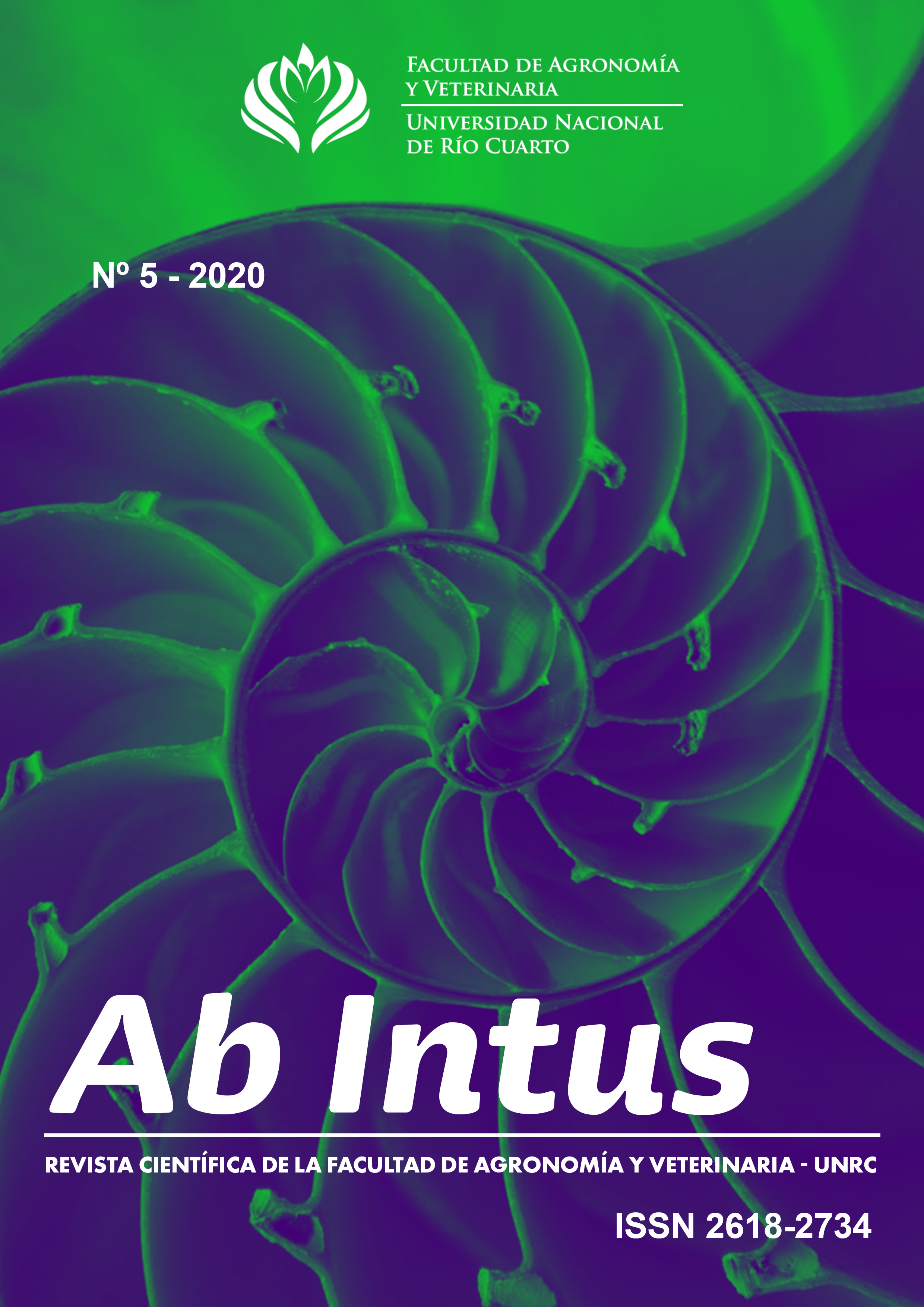Urolithiasis in small ruminants
Abstract
Urolithiasis is a disease affecting the urinary tract of sheep and goat,
being most frequent in intensive and semi-intensive breeding systems. Clinically,
it is characterised by depression, lethargy, teeth grinding, inappetence, oliguria,
leakage of urine in cases of partial obstruction, dehydration, prepucial swelling,
bloating, reluctance to move and death. The most common calculi are those of
silica, struvite, oxalates and phytoestrogens, and their genesis involves nutritional,
environmental, management factors and physiological factors related to
animals, like de age, breed and castration. There are medical treatments based
on sedatives, muscle relaxants, anti-inflammatories, antibiotics, diuretics and
urine acidifyiers, that in early stages of the disease are effective. It is necessary
to deepen research regarding the pathogenesis of the disease and risk factors,
since they are key tools in the early diagnosis, control, and prevention of urolithiasis
in small ruminants.
Downloads
References
Abba, Y., Abdullah, F.F.J., Bin Abu Daud, N.H., Bin
Shaari, R., Tijjani, A., Sadiq, M.A., Mohammed, K.,
Adamu, L., Mohd, A.M.L (2015). Clinical management
of dietary induced urolithiasis associated with
balanoposthitis in a Boer goat. Open Veterinary
Journal. 5: 30–33.
Bailey, C.B. (1981) Silica metabolism and silica urolithiasis
in ruminants: A review. Canadian Journal Animal
Science. 61: 219–235.
Bani Ismail, Z.A., Al-Zghoul, M.F., Al-Majali, A.M.,
Khraim, N.M. (2007). Effects of castration on penile
and urethral development in Awassi lambs. Bulgarian
Journal of Veterinary Medicine. 10: 29-34.
Belknap B.E. y Pugh D.G. (2001). Diseases of the Urinary
System. In Sheep and Goat Medicine, Pugh, D.
G. 2ª edition, W.B. Saunders, Saint. Louis, USA.255–
Boscán, O.J., Sánchez, O.F., Pino, R.D., Sánchez V.A.,
Villarroel N.R., Monasterio O.L. (2004). Estudio de la
obstrucción uretral en un cabrito. Caso clínico. Revista
Científica 14: 1-14.
Bradford, P.S. (2010). Enfermedades del sistema renal
del rumiante. En Medicina interna de grandes
animales. 4ta edición, Elsevier Mosby. España. 949-
Cypher E.E., van Amstel, R.S., Videla, R., Force Clark,
K., Anderson, D.E. (2017). Vesicopreputial anastomosis
for the treatment of obstructive urolithiasis in
goats. Veterinary Surgical. 46: 281–288.
Ewoldt J.M., Jones, M.L., Miesner, D.M. (2008). Surgery
of obstructive urolithiasis in ruminants. Veterinary
Clinical Food Animal. 24: 455–465.
Gazi M.A., Makhdoomi D.M., Mir S.A., Sheikh G.N.
(2016). Urinalysis - A Diagnostic Factor for Urolithiasis
and Prognostic Factor for its Recurrence in Young
Ruminants. Journal of Veterinary Science Technology.
(4): 336-341.
Guimarães, J.A., Mendonça, C.L., Guaraná, E.L.S.,
Dantas, A.C., Câmara, A.C.L., Farias, C.C., Afonso,
J.A.B. (2012). Estudo retrospectivo de 66 casos de
urolitíase obstrutiva em ovinos. Pesquisa Veterinária
Brasileira. 32: 824–830.
Gutiérrez, C.A.B., Mejía, H.J., Badajoz, M.J.J., Barceló,
A.A. (2010). Urolitiasis obstructiva en ovinos: estudio
de caso. Acta Universitaria. 20: 34–39.
Harwood, D. y Mueller, K. (2018). “Urinary Tract Disease”,
Goat Medicine and Surgery, Boca Raton: CRC
Press, Liverpool, UK .237-245.
Instituto de Botánica Darwinion. (2020). Catalogo
on-line de las plantas vasculares del Cono Sur. Volumen
San Isidro, Argentina. http://www.darwin.
edu.ar/proyectos/floraargentina/fa.htm.
Jaramillo, L.E., Itza, O.M.F., Peraza, M.G., Carrera,
C.J.M. (2017). Ruminal acidosis: strategies for its
control. Austral Journal Veterinary Science. 49: 139-
Jubb, K.V.F., Kennedy, P.C., Palmer, N. (2007). “The
urinary system”, Pathology of domestic animals. Vol.
5th Ed., Saunders LTD, New York.2340p.
Kushwaha, R.B., Gupta, A.K., Dwivedi, D.K., Saharma,
A. (2011). Obstructive Urolithiasis in Small Ruminants
and its surgical management. Intas Polivet.
: 359-362.
Lai J.M., Chang, M.H., Hwang, M.Y., Wangs, J.H.
(2017). Urinary retention caused by botched castration
in a goat. Taiwan Veterinary Journal 43: 89-94.
Makhdoomi, D.M. y Gazi, M.A. (2013). Obstructive
urolithiasis in ruminants-A review. Veterinary World.
:233-238.
Minervino, A.H.H., Kaminishikawahara, C.M., Soares,
F.B., Araújo, C.A.S.C., Reis, L.F., Rodrigues, F.A.M.L.,
Vechiato, T.A.F., Ferreira, R.N.F., Barrêto-Junior, R.E.,
Mori, C.S., Ortolani, E.L. (2014). Behavior of confined
sheep fed with different concentrate sources.
Arquivos Brasileiro Medico Veterinaria Zootecnica.
: 1163–1170.
Pearce, S.G., Dearo, A.C., Howard, B.E., Brisson, B.A.
(2003). Management of obstructive urolithiasis and
concurrent urethral rupture in a goat. Australian Veterinary
Journal. 81: 268–270.
Radostits, O.M., Gay, C.C., Hinchcliff, K.W., Constable,
P.D. (2006). Veterinary Medicine, a Textbook of
the Diseases of Cattle, Sheep, Goats, Pigs and Horses
– 10th edition, Saunders Ltd, USA. 2065 p.
Rafee, M.A., Aryambra, S., Baghel, M., Zama, M.M.S.
(2016). Obstructive urolithiasis in kids: A study on
pattern of occurrence, aetiology, age, clinical symptoms
and conditions of bladder and urethra. Veterinaria.
: 1–3.
Riedi, A.K., Knubben-Schweizer, G., Meylan, M.
(2018). Clinical findings and diagnostic procedures
in 270 small ruminants with obstructive urolithiasis.
Journal Veterinary Internal Medicine. 32:1274–1282.
Riet-Correa, F., Simões, S.V., Vasconcelos, J.S. (2008).
Urolitiase em caprinos e ovinos. Pesquisa Veterinária
Brasileira. 28: 319–322.
Samal, L., Pattanaik, A.K., Mishra, C., Maharana,
B.R., Sarangi, L.N., Baithalu, R.K. (2011). Nutricional
strategies to prevent Urolithiasis in Animals. Veterinary
World. 4: 142-144.
Scott, P.R. (2015). “Urinary system”, Sheep medicine.
° edition, CRC Press, Taylor & Francis Group,
University of Edinburgh, UK.274-284.
Singh, A.K., Gangwar, A.K., Devi, K.S., Singh, H.
(2014). Incidence and management of obstructive
urolithiasis in buffalo calves and goats. Advances
Animal Veterinary Science, 2: 503–507.
Sonawane, G.G., Dubey, S.C., Koli, O.P. (2007). Obstructive
urolithiasis in a flock of male weaned sheep
at an organized farm in semiarid Rajasthan. Indian
Journal Veterinary Pathology. 31: 126–129.
Sun, W.D., Zhang, K.C., Wan, J.Y., Wang, X.L. (2010).
The chemical composition and ultrastructure of
uroliths in Boer goats. The Veterinary Journal. 186:
–75.
Downloads
Published
How to Cite
Issue
Section
License
Copyright (c) 2023 Ab Intus

This work is licensed under a Creative Commons Attribution-NonCommercial 4.0 International License.


















